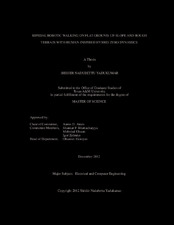| dc.description.abstract | The thesis shows how to achieve bipedal robotic walking on flat-ground, up-slope and rough terrain by using Human-Inspired control. We begin by considering human walking data and find outputs (or virtual constraints) that, when calculated from the human data, are described by simple functions of time (termed canonical walking functions). Formally, we construct a torque controller, through model inversion, that drives the outputs of the robot to the outputs of the human as represented by the canonical walking function; while these functions fit the human data well, they do not apriori guarantee robotic walking (due to do the physical differences between humans and robots). An optimization problem is presented that determines the best fit of the canonical walking function to the human data, while guaranteeing walking for a specific bipedal robot; in addition, constraints can be added that guarantee physically realizable walking. We consider a physical bipedal robot, AMBER, and considering the special property of the motors used in the robot, i.e., low leakage inductance, we approximate the motor model and use the formal controllers that satisfy the constraints and translate into an efficient voltage-based controller that can be directly implemented on AMBER. The end result is walking on flat-ground and up-slope which is not just human-like, but also amazingly robust. Having obtained walking on specific well defined terrains separately, rough terrain walking is achieved by dynamically changing the extended canonical walking functions (ECWF) that the robot outputs should track at every step. The state of the robot, after every non-stance foot strike, is actively sensed and the new CWF is constructed to ensure Hybrid Zero Dynamics is respected in the next step. Finally, the technique developed is tried on different terrains in simulation and in AMBER showing how the walking gait morphs depending on the terrain. | en |


